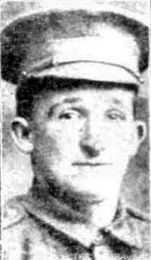Difference between revisions of "William Wilfred Gerald Liddington"
From Our Contribution
| Line 121: | Line 121: | ||
[[Category:Soldier]] | [[Category:Soldier]] | ||
| + | [[Category:1918 WIA]] | ||
Revision as of 13:17, 27 June 2017
 Western Mail | |
| Personal Information | |
|---|---|
| Date of Birth | unknown |
| Place of Birth | Kelmscott, Western Australia |
| Death | 22 Nov 1948 |
| Place of Death | Hollywood Repatriation Hospital, Nedlands, Western Australia |
| Age at Enlistment | 19 years, 4 months |
| Description | 5' 3" (1.60m) tall; weight 133 lbs (60.3 kg); fresh complexion, brown eyes, dark brown hair |
| Occupation | farm labourer |
| Religion | Roman Catholic |
| Address | East Cannington, Western Australia |
| Next of Kin | Father Mr John Liddington |
| Military Information | |
| Reg Number | 6105 |
| Date of Enlistment | 3 Aug 1916 |
| Rank | Private |
| Unit/Formation | 28th Battalion, 17th Reinforcement transferred to 16th Battalion and to 4th Machine Gun Battalion / 4th Division |
| Date of Embarkation | 9 Nov 1916 - 10 Jan 1916 |
| Ship Embarked On | HMAT A8 Argyllshire |
| Date of Return | 21 Mar 1919 - 27 Apr 1919 |
| Ship Returned On | SS Kildonan Castle |
| Fate |
Wounded in Action (gassed) 20 Aug 1918 at Chuignes Returned to Australia |
| Monument | Canning Honour Board |
| Medals |
British War Medal Victory Medal |
Pre War
War Service
Initially allocated to the 18th reinforcement draft for the 28th Battalion, he was transferred to the 17th draft while in Western Austalia.
On arrival in England he was posted to the 7th Training Battalion in Rolleston before proceeding to France on 25 Apr 1917 where he was taken on strength by the 28th Battalion on 2 May 1917 as it moved from Bapaume into the front line in the Somme Valley.
Four days later he was charged with being late on parade and being dirty on parade. On 30 Aug 1917 he was charged with being AWOL for 30 minutes. Transferred to 16th Battalion on 13 Oct 1917 after the 28th had suffered heavy casualties in the Broodseinde Ridge action.
The 16th at this time were in the front and support lines on Westhoek Ridge. Enjoyed a period of leave in Jan 1918 before being again transferred, this time to the 4th Machine Gun Battalion on 12 May 1918 in the Blangy - Villers-Bretonneux area.
On 20 Aug 1918, while in the Harbonnieres area, Bill was affected by a gas shell. Initially seen at the 37th Casualty Clearing Station, the next day he received treatment from 4th Australian Field Ambulance, and 12th Casualty Clearing Station before finishing up in 2nd Stationary Hospital at Abbeyville. He rejoined his unit on 16 Sep 1918 without the need for treatment in England.
On leave in the UK from 11 to 25 Nov 1918, in March 1919 he began the journey home from Le Havre to Southampton and then to Sutton Veny, before boarding the SS Kildonan Castle in Devonport.
Disembarked in Fremantle on 17 Apr 1919 and discharged by 5th Military District on 12 Jun 1919.
Post War
Older brother George William who was born in Pinjarra was an inaugural member of 16th Battalion. Father (NOK) died before Bill came home (7 Jan 1918).
Electoral Roll entries - 1922 a mill hand at Nanga Brook; 1925 at the 9 Mile Camp Peel Estate, a horse driver; 1931 a teamster at Henry street East Cannington with Mother Mary Ann who died there on 2 Feb 1932 aged 72. 1934 by himself at Henry street. In 1949 a notice in paper from step children Phyllis and Wallis as well as their mother Rose Eliza.
Notes
resident of Cannington who died in the Repatriation General Hospital, Hollywood